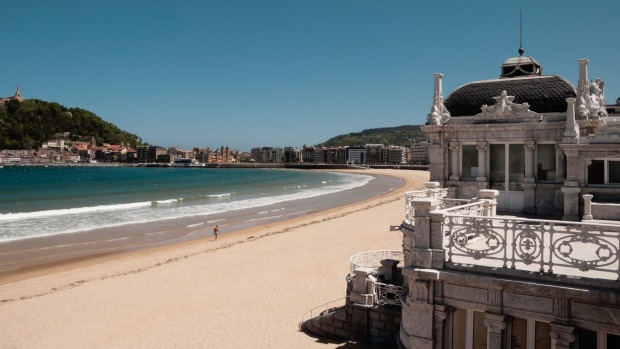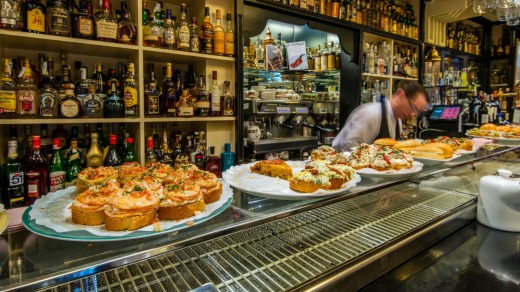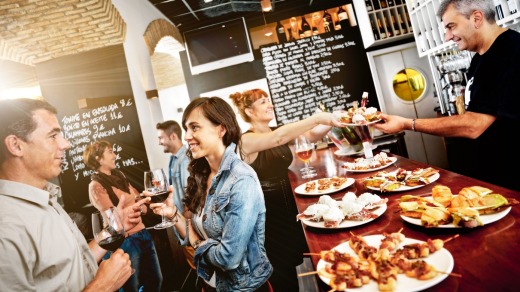
There's a nagging feeling that slowly takes hold as you spend time in San Sebastian. It starts when you arrive, a shadow of an idea in the back of your mind as you walk the streets of the old town or neighbouring Gros, these twin towns sprawled with equal beauty on either side of the Urumea River, and notice the bars. Not what's inside them. Not even what they offer. Just the sheer number. Hundreds. Maybe thousands.
Choose one of those bars at random and wander in, noticing the colourful array of food spread across the counter, the bite-sized portions of culinary perfection lined up one after the other. Call into a few more bars, and then a few more, and you realise that each has an incredible range of food and good wine, and they're all packed with locals laughing, joking and eating, eating, eating.
After a few nights, a few more dinners and snacks and drinks and desserts, that shadow of an idea turns into a deep conviction: San Sebastian is the greatest place in the entire world.

This beachside town on the northern coast of Spain, in the heart of Basque country, is foodie paradise. It has more Michelin stars per capita than almost any other place on earth (save for Kyoto). It's home to two of the world's top 20 restaurants. It's a city that lives for good food, whether that's a simple dish eaten standing up at a bars, or the most complex work of gastronomic art at a three Michelin star fine-diner.
There's much more to love about San Sebastian – its twin beaches, its rugged coastal headlands, its classic European architecture or the fact that in 2016 it will be named the European capital of culture – but, let's be frank, you're here to eat. And you'd better hope you're hungry.
San Sebastian wakes late, and down at La Bretxa market, the stall owners are still arranging their gourmet wares as you settle into a little bar and order a "tortilla de patatas" – a slice of omelette filled with potatoes – and a coffee. It's not much, but it pays to have a light breakfast around here, because there's plenty more come.

Most people spend their mornings in San Sebastian wandering the boulevards of the CBD, window shopping, maybe taking a dip at a beaches, or strolling the promenade, working up an appetite for the day's first true highlight: lunch.
This is not Spanish food – to suggest that would probably get you booted out of the city. San Sebastian – or Donostia to its residents – is a fiercely Basque territory. The preferred method of eating here isn't tapas, but "pintxos", an even smaller version of that Spanish style that allows patrons to taste as many morsels as possible.
While the bulk of San Sebastian's pintxos bars and restaurants can be found in the Parte Vieja, or old town, there's still plenty going on across the river in the far less touristy Gros area. There you'll immediately stumble upon Hidalgo 56, a bar that specialises in experimentation. Basque fare isn't trapped by tradition, but freed by it. It's constantly evolving.

On the menu today: a "volcano" of morcilla topped with a raw egg yolk, a plate of raw tuna spiked with fresh strawberries, and a smoked cheesecake. Wash it down with a glass of txakoli, the Basque sparkling wine and you're starting to get an idea of just how great San Sebastian is.
And it's a city that demands you move on. Onward into Gros, to Casa Senra, a friendly, spacious bar where you can order slow-cooked beef cheek topped with a slice of foie gras, or cuttlefish with seaweed and chestnut puree. Head around the corner to Bar Bergara for noodles with garlic mayonnaise, or crumbed salt-cod with tomato.
Here's the deal with a San Sebastian pintxos bar. You have "pintxo beroak" and "pintxo hotzak" – essentially cold tapas and hot tapas. The cold dishes are laid out on the counter at every bar, but it's bad form to just help yourself. Point to what you want and the barman will put it on a plate for you. Eat standing up. Wipe your face with a napkin and then throw it on the floor. That's the local style.
To order a hot pintxo, tell the barman what you want from the menu on the wall. He'll yell out when it's ready. Don't attempt to pay for drinks or food until you're ready to leave. And don't expect to be given a bill – barmen in San Sebastian manage to keep track of everyone's orders (and often their names) in their heads. They'll tell you what you owe.
Ready for dinner? This is when the Parte Vieja comes into its own, when its narrow streets fill with voracious diners, and its bars throw open their doors, ready to serve their house specialty. At Goiz Argi it's skewers of grilled prawns served with onion vinaigrette. At Ganbara it's mushrooms topped with an egg yolk. At San Telmo it's calves liver with madeira sauce. At A Fuego Negro it's mini-hamburgers. At La Vina, baked cheesecake.
And it goes on throughout the city. Every night. And these are just the bars. We haven't touched on the restaurants, the likes of Mugaritz, the sixth-best eatery in the world, or Arzak, the 17th. We haven't talked about the stunning hilltop Mirador de Ulia, or the famed Restaurante Martin Berasategui.
For foodies, this is heaven. And it's always time to eat.
See sansebastianturismo.com
Qantas flies daily from Sydney to Madrid, via Dubai. See qantas.com. From Madrid, trains run twice daily to San Sebastian. See renfe.com.
The Hotel NH Collection is next to the old town, and has rooms from $198 per night. See nh-hotels.com.
See also: The 50 dishes every traveller must try, at least once